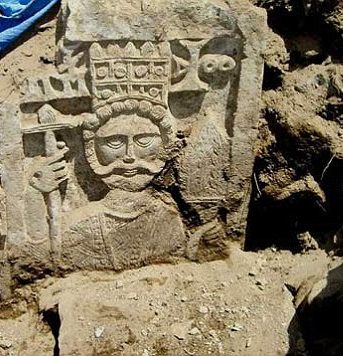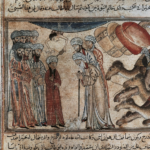
We should not lose sight of the fact that the Arabs, ever since ancient times, had mixed with Greek merchants, then Romans, Egyptians, Phoenicians, and Abyssinians, and that there were journeys and migrations between East Africa and Yemen. The Romans colonized Palestine, Syria, Egypt, and Asia Minor (present-day Turkey) and, around the year 320 AD, the Roman Emperor Constantine converted to Christianity and made it the official religion of the empire.
SINCE THE ROMAN Empire had hostile relations with the Sasanian Empire in Persia, the Roman Empire in Constantinople sought the help of the Arabs of northern and central Arabia to protect its borders from the attacks of the Sasanian Empire and to protect the trade routes from bandits. Some Arab tribes, particularly the Ghassānids and the Thammūdids, even became functionaries of the Roman Empire. All the tribes that cooperated with the Roman Empire were introduced to Christianity, and some of them embraced this new religion.
The Council of Ephesus in 431 AD was convened put an end to the disputes that began in the Eastern Church in Constantinople over the definition of the nature of Christ – whether Christ had a human nature or a divine nature. The Eastern Church in Constantinople insisted on the doctrine of the Trinity, which says that the Father, the Son, and the Holy Spirit all mean the one God in three Persons. As for the followers of the one nature of Christ, the Monophysites in Alexandria and the Jacobites in Syria, these insisted that Christ had two natures, a human nature and a divine nature, but that they could not be separated. A third group, led by Bishop Nestorius, said that Christ had two separate natures, and they could indeed be separated. This led to the expulsion of Bishop Nestorius, who fled to Iraq with his followers – who became known as the Nestorians – and gained adherents in Persia and Iraq.
The Sasanian Empire, at a time of disarray, had hired the services of the Banū Mundhir tribe to protect its borders with the Roman Empire. The Banū Mundhir consequently came into contact with the Christians, with some of them converting to Christianity. Subsequently Nestorian Christian monks spread over the Arabian Desert living in monasteries and tents among the Arabs. Some of these monks excelled in treating these nomadic Arabs using supplications, prayers, and herbs, which influenced some tribal leaders to convert to Christianity, with some tribal members following suit.
The period that preceded Islam was thus not a period of ‘ignorance’ (jāhiliyya) as portrayed by the Prophet of Islam and the shaykhs who came after him
By the fourth century AD we can say that the Arabs of the Arabian Peninsula in the cities and in the deserts and had become acquainted with Christianity, with a large part of them embracing it.
Back in the year 722 B.C. the Assyrians invaded the northern kingdom of the Children of Israel, captured the ten northern tribes and deported them to Babylon. According to Assyrian policy, they then dispersed the captives to different regions of the empire to prevent them from collecting together and causing disturbance to the empire. Later, in 586 BC, they conquered the two southern tribes and deported these as captives to Babylon. The Jews then remained in Iraq for several decades during which time they absorbed Babylonian and Sumerian mythology. They collected the oral sayings of Moses into the Mishna, then wrote down the Hebrew laws in the Babylonian Talmud before returning to Palestine. Subsequently the Romans invaded Palestine and destroyed the Jewish temple in Jerusalem (the Temple of Solomon) in the year 70 AD. The Jews then dispersed over the Arabian Peninsula from Yathrib to Yemen. The people of Yemen perforce came under the influence of Judaism, and some adopted this faith, the kings of Himyar in particular.
Finally, the Ethiopians came to Yemen, colonized it and practiced their Eastern Christianity there, building churches and encouraging the population to convert to Christianity, which spread extensively over the Najran region and in Aden. It appears from all the above that by the end of the fourth century AD the Arabs of the peninsula had been exposed to Christianity, Judaism and idolatry. The period that preceded Islam was thus not a period of ‘ignorance’ (jāhiliyya) as portrayed by the Prophet of Islam and the shaykhs who came after him. On the contrary the Arabs, even in the desert, were familiar with the monotheistic religions, as is evident from the poetry of the poets of that period, such as Umayya ibn Abī al-Ṣalt, Hassān ibn Thābit before he converted to Islam, and the sermons of Quss ibn Sa`ida al-Ayādī. Umayya ibn Abī al-Ṣalt says the following on the sky:
He built it and made it seven-fold strong without pillars to see or legs beneath,,
He made it, adorned it with light, from the radiant sun and the crescent moon,
And from meteors that sparkle in the dark, whose range outstrips every blade. [1]
Most of the Arabs were aware of the existence of God and that He is the creator of the universe. The Qur’ān itself says that
If you ask them, Who created the heavens and the earth and made the sun and the moon subservient, they will certainly say, Allah. [2]
As for the stories of the Qur’ān that were said were not known even to Muḥammad, the Arabs knew them, and among them too were those who knew Babylonian and Persian myths, such as al-Naḍr ibn al-Hārith who had traveled to Persia and Iraq and heard all the legends. He used to follow Muḥammad in his gatherings and tell the Arabs that he could tell them better tales than Muḥammad’s. So when Muhammad captured him at the battle of Badr, he refused to release him with a ransom, and ordered ‘Alī ibn Abī Ṭālib to cut off his head.

Suggested Reading
Al-Islām yujibb mā qablahu – ‘Islam wipes away what came before it.’ This saying had the greatest impact on the blockading of Arab literature and culture before Islam, in an attempt by Muslims and their Prophet to show Islam as a religion that came with values and teachings that were unknown to the pre-Islamic Arabs, whom Muhammad called the Jāhilīs (‘ignorant ones’). Muḥammad and those who came after him attempted to obliterate the features, civilization and culture of pre-Islamic Arabs in order to show that Islam came to ignorant people who did not know anything about morals and tolerant values. Dr. Shaker Al-Nabulsi made the following comments on this:
“The reason for the obliteration of this literature by Islam may be:
1- That this prose contains religious teachings that contradict the teachings of Islam;
2- That most of this prose is made up of Christian or Jewish sermons to Arabs before Islam;
3- That in this prose there are passages of wisdom and proverbs that the Qur’ān later also brought;
4- That this prose includes biographies and historical accounts that were later cited in the Qur’ān;
5- That this prose contains what was stated in the previous holy books (the entirety of this prose is related to sermons covering preaching and advice on matters of the Christian and Jewish faiths, on behavior and thought);
6- That this prose contains morals and customs of the Arabs against which Islam fought;
7- That this prose is entirely oral literature, not written down, with most of it lost due to the passing away of its authors and creators;
8- That the prominent figures who cited or authored this prose were among the staunch enemies of Islam, its creed and the Messenger;
9- That this prose contains exhortation to virtuous morals, while Islam accuses this period of being one of ignorance and falsehood, and said that the people were immoral, and denied that they practised any virtuous morals;
10- That the eloquence in this prose competed with the magic of the Qur’ān.”[3] The little that we have received from the prose of that period before Islam shows us that the eloquence and charm of the sermons of Quss ibn Sāʽida al-Ayādī matched the magic of the Qur’ān and perhaps surpassed it.”
Quss ibn Sāʽida al-Ayādī[4] preceded Muhammad in several expressions that the Qur’ān later brought. For example. in one of his sermons, Quss stated:
O people of the Iyād tribe, where now are Thamud and Ad? And where are the fathers and ancestors? And where are the ailing and the mourners? Each of them will have his place in the Hereafter, the priest Quss so swears by of the Lord of all His Servants! You will be gathered alone on the day of calling, when the trumpet is blown, and the bells are rung, and the earth shines resplendent, and when the preacher preaches, when the despondent withdraws and the observant sees.
So woe to the one who turns away from the most patent truth, the brightest light, the greatest honour, on the Day of Judgment with its scales of justice, when the Almighty judges, and the warner bears witness, when any helper is far removed, when shortcomings become patent, where there will be a group destined for Paradise, and another for Hellfire!
Muhammad used most of these terms and phrases in his Qur’ānic verses.
[1] This is from Umayya ibn Abī al-Ṣalt’s famous ode إِلَهُ العــــالَمــــيـــنَ وَكُـــلِّ أَرضٍ (‘The God of the Worlds and all the Earth’). The poet, who was a contemporary of Muḥammad, himself claimed prophethood, and the antagonism between the two led to the censorship of his poems. Clement Huart in his study Une nouvelle source du Qur’ān (1904) argued that Umayya, being older than Muḥammad may have served as a model for Muḥammad, who may have taken some verses of Umayya for the composition of the Qur’ān. A summary of this argument on Umayya ibn Abī al-Ṣalt is provided by Al Makin: ‘Re-thinking other claimants to Prophethood: the case of Umayya ibn Abī al-Ṣalt’ in Al-Jāmiʽah, Vol. 48, No.1, 2010. (Ed.)
[2] Qur’ān XXIX (al-ʽAnkabūt) 61.
[3] Shakir al-Nabulsi, لو لم يظهر الإسلام ما حال العرب الآن (‘If Islam had not emerged, what would be the state of the Arabs today?’) Dār al-Āfāq al-Jadīda, Beirut, 1st. ed. 2003, p.95.
[4] Quss ibn Sāʽida al-Ayādī was the bishop of Najran in the 6th-7th century. Scholars argue that the young Muḥammad listened to his sermons at the famous market at al-Ukāẓ before the Revelation of the Qur’ān in 610. His eloquent Arabic expression became proverbial, as illustrated in the phrase ablagh min Quss (‘more eloquent than Quss’). (Ed.)
Main image: A stone carving of a Christian figure found in Zafar, Yemen
See Part 1 of this essay here
